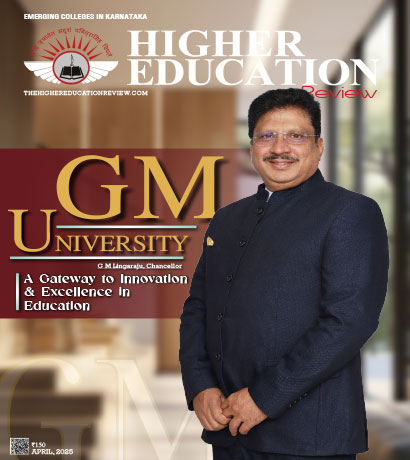Is Ed-Tech A Threat Or An Opportunity For The Traditional Schooling System?

Pranav Raj Aggarwal, Executive Director, International School of Design (INSD)
Labs across the country are testing artificial intelligence, virtual reality and other innovations that could improve learning and lower costs for Generation Z and beyond.
The higher education degree as we know it has been in the doldrums for a while. Increasingly, as jobs across both traditional and new-age industries place less emphasis on graduate programmes, online courses become easily available, and specialized short-duration certificates gain popularity, young people question the value and need for what is almost always an expensive degree.
The traditional classroom-based education system needs to accept its insufficiency and join forces to refine knowledge and learning in the post COVID era. The COVID-19 pandemic is wreaking havoc globally and nothing can be done until a feasible vaccination is curated. The health crisis has demolished the link between students and the education system and brought the cycle to an abrupt halt. However, the edtech sector is regaining its powerful traction and has stirred up thoughts about the digital education system amid the pandemic. Google Trends graph for edtech queries of the past 90 days has witnessed a 60 per cent boost in the user search patterns. Furthermore, as the effects of Covid-19 accelerate ed-tech adoption, it is clear that traditional education will require a re-think. In particular, MBA programmes that were already seeing a decline in applications in many countries, now see themselves questioning the status quo.
Covering any digital technology that augments or facilitates learning, the landscape of this market is vast. EdTech can comprise custom learning experiences, using gadgets and interfaces to provide learning based on need, preference, and availability. It could be the use of cloud computing, allowing students to access course files and collaborate with one another wherever they are. It could be the use of voice assistants or VR to provide more novel, immerse, or practical methods of learning. As students demand more personalized approaches to learning - the answer lies in technology.
AI learns how a student best learns most effectively, and provides tailored lessons and tests with a "personalized path to mastering each subject", by playing off individuals' strengths and weaknesses.
But it also seeks to alleviate the burden of admin tasks from teachers themselves - like marking and planning - that swallows up teaching staff's time in and outside of school hours. Teachers can also use the program to view detailed insights on each student's performance, providing them rich information to perform better ad educators. As a result, they can spend more time on more valuable activities, such as one-to-one feedback sessions with students.
Edtech platforms have mushroomed over the past three-four years with a compelling teaching system that is intuitive and rewarding. They have succeeded in jolting the audience with a diverse curation of practicable courses. Riding high on the USP of not being reliant on a physical location for existence, the outreach of these platforms is massive as they only require a computer with an Internet connection.
Many professors and education professionals are discovering that rather than distract, strategically applied devices increase engagement with students, especially those with learning disabilities, who are on the autism spectrum and for whom English is a second language. Technology is the great equalizer that allows every student to learn in the way they need to learn or want to learn, to the greatest extent that they want to learn. When you ban technology, you close off access between the classroom and the world outside. And on the other hand, when you open up the classroom with technology, you are giving students the ability to connect to translation services, with databases to do research in real time, with other people they can connect with to get questions answered, because the instructor is only one person. If you are finding your students are being distracted on their cellphones or on laptops, you have to ask yourself: What am I doing in my teaching that is not engaging? How can I give them opportunities to participate so they don't feel the need to disappear down the rabbit hole?
“Technology has helped spawn a new generation of digital citizens who are learning how to use technology in a social, positive manner geared toward learning”
Needless to say, technology is omnipresent in our lives today- the workplace, in our homes, on our person and, now, in our schools. It figures that given the digital transformation of workplaces across industries- and the increasing automation of our businesses- the next generation of workers are early immersed in a culture of experimentation and innovation with emerging technologies and software. But that's not the sole aim of technology for education- a growing market more commonly referred to as EdTech. It also offers an alternative to `traditional' classroom learning methods, engaging students which new, innovative formats, and the ability to tailor approaches to fit the individual student.
Technology has figured out how to level the playing field across different types of schools and districts to help close the digital divide. And it has helped spawn a new generation of digital citizens who are learning how to use technology in a social, positive manner geared toward learning. Schools can be left scrambling to find ways to give each student full access to a good education. At low cost and with easy-to-use tools, technology has skinned the cat.
Pranav Raj Aggarwal, Executive Director
Pranav is a driven and motivated director of a design education institution driving change in the non-STEM education sector of India. His vision for the International School of Design (INSD) is to create cross-border initiatives that curate and design curriculums to create an immersive student experience, equipping students with the knowledge and skills to understand and implement modern-day design techniques and traditional ways of art Having studied and worked in over 4 countries across Europe and Asia, his understanding of different cultures and pedagogy techniques make him a fantastic fit to strategize and devise curriculums that make education much more than just classroom learning.
The higher education degree as we know it has been in the doldrums for a while. Increasingly, as jobs across both traditional and new-age industries place less emphasis on graduate programmes, online courses become easily available, and specialized short-duration certificates gain popularity, young people question the value and need for what is almost always an expensive degree.
The traditional classroom-based education system needs to accept its insufficiency and join forces to refine knowledge and learning in the post COVID era. The COVID-19 pandemic is wreaking havoc globally and nothing can be done until a feasible vaccination is curated. The health crisis has demolished the link between students and the education system and brought the cycle to an abrupt halt. However, the edtech sector is regaining its powerful traction and has stirred up thoughts about the digital education system amid the pandemic. Google Trends graph for edtech queries of the past 90 days has witnessed a 60 per cent boost in the user search patterns. Furthermore, as the effects of Covid-19 accelerate ed-tech adoption, it is clear that traditional education will require a re-think. In particular, MBA programmes that were already seeing a decline in applications in many countries, now see themselves questioning the status quo.
Covering any digital technology that augments or facilitates learning, the landscape of this market is vast. EdTech can comprise custom learning experiences, using gadgets and interfaces to provide learning based on need, preference, and availability. It could be the use of cloud computing, allowing students to access course files and collaborate with one another wherever they are. It could be the use of voice assistants or VR to provide more novel, immerse, or practical methods of learning. As students demand more personalized approaches to learning - the answer lies in technology.
AI learns how a student best learns most effectively, and provides tailored lessons and tests with a "personalized path to mastering each subject", by playing off individuals' strengths and weaknesses.
But it also seeks to alleviate the burden of admin tasks from teachers themselves - like marking and planning - that swallows up teaching staff's time in and outside of school hours. Teachers can also use the program to view detailed insights on each student's performance, providing them rich information to perform better ad educators. As a result, they can spend more time on more valuable activities, such as one-to-one feedback sessions with students.
Edtech platforms have mushroomed over the past three-four years with a compelling teaching system that is intuitive and rewarding. They have succeeded in jolting the audience with a diverse curation of practicable courses. Riding high on the USP of not being reliant on a physical location for existence, the outreach of these platforms is massive as they only require a computer with an Internet connection.
Many professors and education professionals are discovering that rather than distract, strategically applied devices increase engagement with students, especially those with learning disabilities, who are on the autism spectrum and for whom English is a second language. Technology is the great equalizer that allows every student to learn in the way they need to learn or want to learn, to the greatest extent that they want to learn. When you ban technology, you close off access between the classroom and the world outside. And on the other hand, when you open up the classroom with technology, you are giving students the ability to connect to translation services, with databases to do research in real time, with other people they can connect with to get questions answered, because the instructor is only one person. If you are finding your students are being distracted on their cellphones or on laptops, you have to ask yourself: What am I doing in my teaching that is not engaging? How can I give them opportunities to participate so they don't feel the need to disappear down the rabbit hole?
“Technology has helped spawn a new generation of digital citizens who are learning how to use technology in a social, positive manner geared toward learning”
Needless to say, technology is omnipresent in our lives today- the workplace, in our homes, on our person and, now, in our schools. It figures that given the digital transformation of workplaces across industries- and the increasing automation of our businesses- the next generation of workers are early immersed in a culture of experimentation and innovation with emerging technologies and software. But that's not the sole aim of technology for education- a growing market more commonly referred to as EdTech. It also offers an alternative to `traditional' classroom learning methods, engaging students which new, innovative formats, and the ability to tailor approaches to fit the individual student.
Technology has figured out how to level the playing field across different types of schools and districts to help close the digital divide. And it has helped spawn a new generation of digital citizens who are learning how to use technology in a social, positive manner geared toward learning. Schools can be left scrambling to find ways to give each student full access to a good education. At low cost and with easy-to-use tools, technology has skinned the cat.
Pranav Raj Aggarwal, Executive Director
Pranav is a driven and motivated director of a design education institution driving change in the non-STEM education sector of India. His vision for the International School of Design (INSD) is to create cross-border initiatives that curate and design curriculums to create an immersive student experience, equipping students with the knowledge and skills to understand and implement modern-day design techniques and traditional ways of art Having studied and worked in over 4 countries across Europe and Asia, his understanding of different cultures and pedagogy techniques make him a fantastic fit to strategize and devise curriculums that make education much more than just classroom learning.

